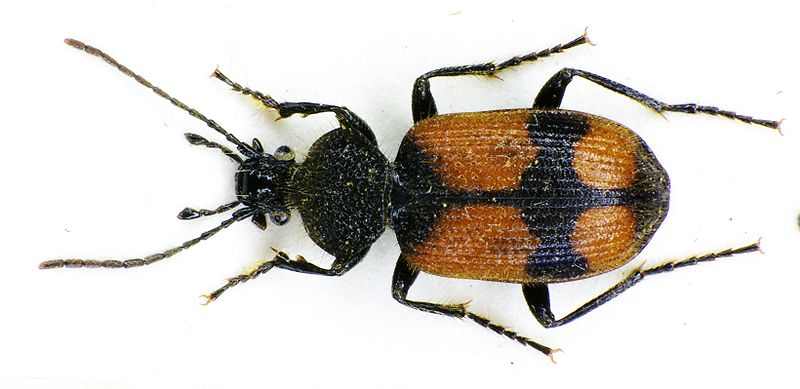
Ground beetles are members of the Carabidae family of insect with about forty thousand species worldwide, two thousand of which live in North America. They are variable in size and color depending on the species but most adults are glossy and black, although some are green, yellow, orange or iridescent. They are between 1/8-1.25 inches long, have flattened bodies, long powerful legs, rigid, grooved wing covers, and large heads with large eyes.
Most ground beetles are nocturnal predators. They live in grassy areas and under rocks, logs, leaves, or clods of dirt but come out at night to eat at ground level. Their diet includes mites, springtails, snails, slugs, aphids, maggots, grubs, and caterpillars. They are helpful in controlling a large number of pests such as army worm, Japanese beetle, wireworm, European corn borer, gypsy moth, wireworm, Colorado potato beetle and cucumber beetle. Unfortunately they also eat some beneficial fauna like butterfly caterpillars and earthworms. Some ground beetles eat the seeds of plants and are important in controlling weeds such as common ragweed, common lambsquarters, crabgrass, morning glory, pigweed, chickweed and giant foxtail.
Ground beetles go through complete metamorphosis with four stages: egg, larvae, pupa, and adult. The female typically lays deposits thirty to six hundred eggs on the surface of the soil or in plant litter and the larvae that emerge live below the soil surface and feed. After three larval stages, they pupate, and then emerge as adults.
The best way to sustain a population of ground beetles is to provide a good habitat in the form of a beetle bank. This is an area permanently planted with perennial native grasses that provide for cover for the adults and undisturbed soil for the larvae. Avoidance of broad spectrum insecticide is also imperative.